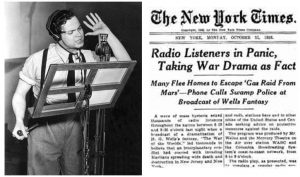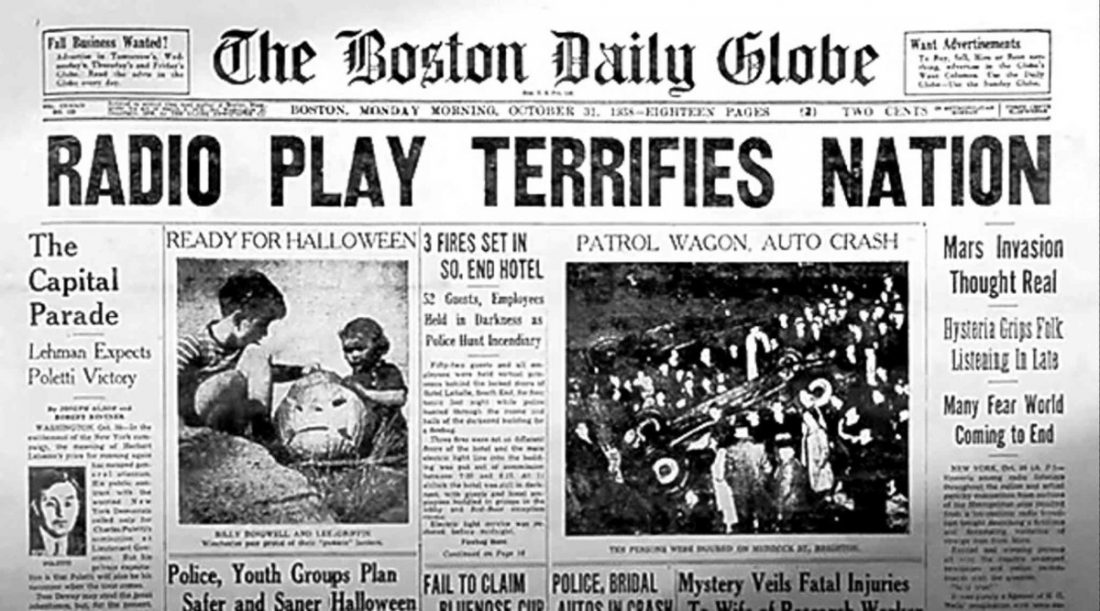By T. Adler
On Halloween in 1938, the CBS radio network aired a play adaptation of the classic War of the Worlds novel by H.G. Wells. The play was formatted like a real radio news broadcast. It started with the weather and a performance by an orchestra. Reports of explosions on Mars occasionally interrupted the otherwise realistic orchestra performance. Half an hour in, there was an “emergency bulletin” about a UFO that landed in New Jersey. Reporters on site described “a humped shape” with incineration lasers slaughtering soldiers and police. The newscaster told his audience that aliens had invaded Earth and there was no doubt who would be the victor in this war. According to urban legend, thousands of Americans were panicked by the hyper-realistic play. People to this day believe that the broadcast caused car accidents, heart attacks, threats of suicide, and dozens of cases of shock.
The truth is much duller. Very few people tuned into the broadcast and even fewer were frightened, let alone to the extent depicted by urban legend. A survey completed by C.E. Hooper ratings service the night of the broadcast reported that only 2% of radio listeners were even tuned into CBS. Most listeners were instead listening to a performance by a family favorite: ventriloquist Edgar Bergen. Of the few that were listening to the radio show, even fewer missed the introduction (which explicitly stated that all events to be described were entirely fictional) and the multiple intermission breaks with the same disclaimer. Of those who missed every sign, most “looked at it is as a prank,” according to CBS Broadcasting Executive Frank Stanton[1].
Of course, it is true that a few people panicked at the fake news reports. A good portion of those who fell for the broadcast believed that the invaders were not aliens, but instead Germans, as 1938 was a time of high anxiety over the possibility of war. However, there is no evidence of a panic of the size that has cemented itself in American myth and legend.

The common perception of that night was the same in 1938. Most people believed, even then, that mass hysteria swept the country as a result of the conniving Orson Welles. For example, in 1938, the New York Times published an article describing the effects of the broadcast on an impossible scale: thousands of calls, hundreds of people evacuating their cities and homes, several cases of shock, a few attempted suicides. They even wrote that “in New Orleans a general impression prevailed that New Jersey had been devastated by the ‘invaders.’” Investigators attempted to find evidence of any attempted or successful suicides and found none. Additionally, no people were admitted to hospitals with shock that night. The New York Times is a newspaper that forged a reputation through vigorous fact-checking and solid reporting. They have always tried to distinguish themselves from the sensationalist papers with flashy headlines that have often sold better. It is surprising that a newspaper like the New York Times would rely so heavily on rumor and hearsay. While it remains unclear why this article was published with so much easily discredited information, this suggests that even the most reputable sources are not immune from sensationalism.
Another cause of this pervasive myth is a book called The Invasion from Mars written in 1940 by Princeton psychology professor Henry Cantril. This book attempted to explain the psychology behind the supposed “mass hysteria” in 1938. His psychological analysis might have been accurate and insightful, but his investigative skills were lacking. Cantril wrote that “millions” of listeners were panicked by the broadcast, although he later admitted that a number so large was improbable. He went on to describe nonexistent disasters that resulted from this panic. Sensationalist newspaper accounts and an effort to make his book succeed commercially probably influenced his book.
Orson Welles himself did very little to dispel this myth. He played along, later admitting that he “was hiding his delight that Halloween morning.” He knew it was in his favor for the newspaper to cause a ruckus. Indeed, the publicity he received for his radio play boosted his profile and opened doors for him in Hollywood. He was hired to direct Citizen Kane in 1941, three years after the radio play made him a household name.
Whether as a result of news sensationalism or pseudo-academic research or a writer’s delight at finally receiving some publicity, the story of “mass hysteria” spread and passed from generation to generation, becoming part of American myth and legend.
The New York Times article published the day after the play aired reads like a description of a Twilight Zone episode. It’s exciting, vivid, and most importantly, reveals something dark in human nature. It appeals to the same instinct that makes horror movies so entertaining. It’s true that people are attracted to stories with these themes and so long as these stories are recognized as fiction, there is no problem with that. However, the willingness of reputable newspapers to publish these stories claiming they are real, and the willingness of the populace to accept them as truth, does reveal a problem. In the era of the internet, where news stories are held to an even lower standard of accuracy, a gravitation towards these types of stories could have devastating effects on democracy.
[1] Corydon B. Dunham, Fighting for the First Amendment: Stanton of CBS vs. Congress and the Nixon White House. Praeger, 1997.

1 comment on “How Fake News Made a Fake News Story Famous”
Comments are closed.